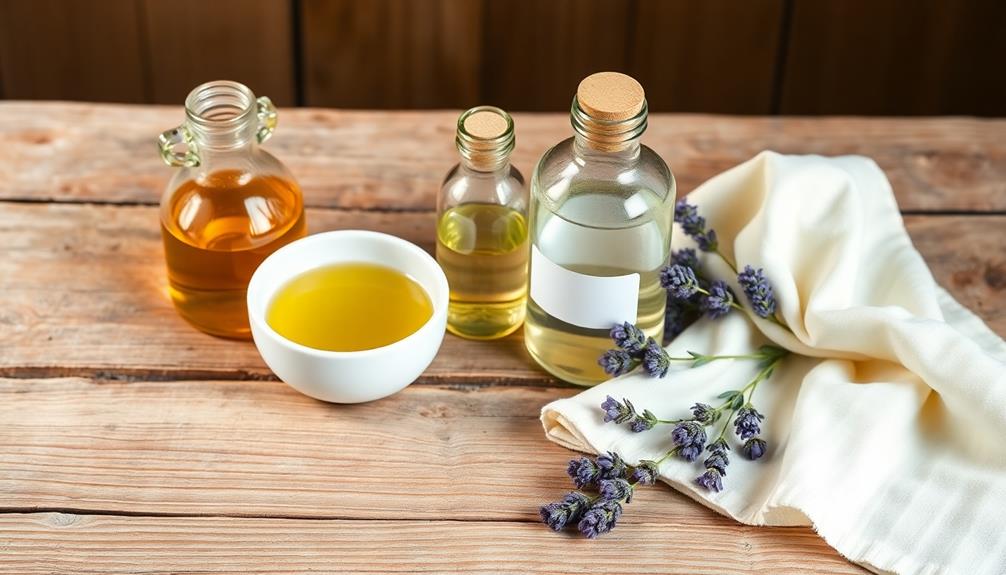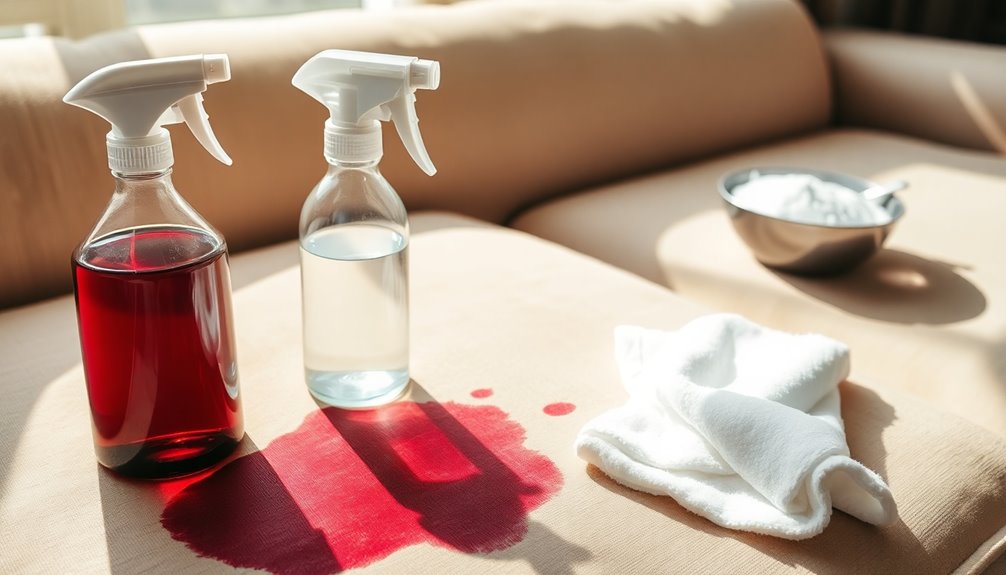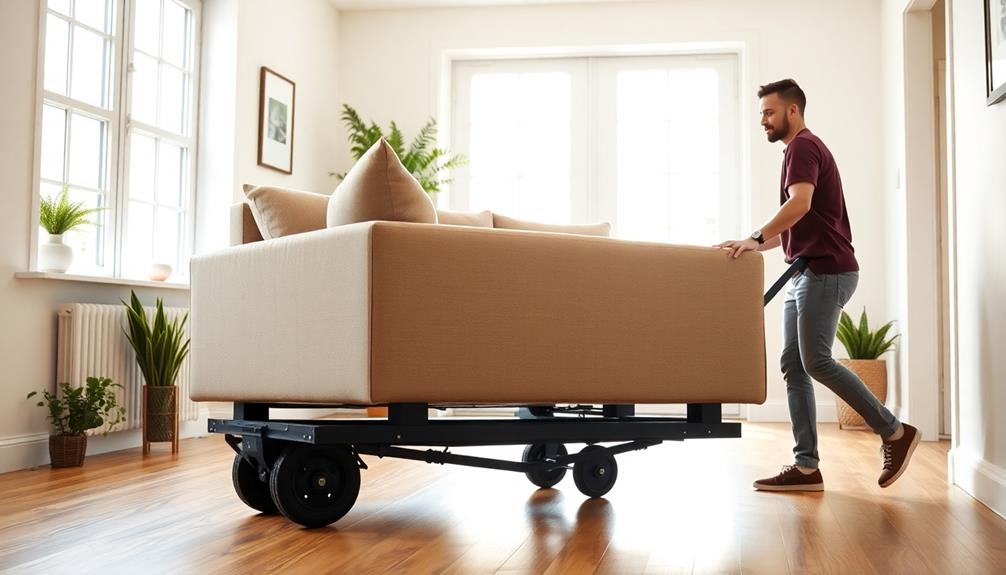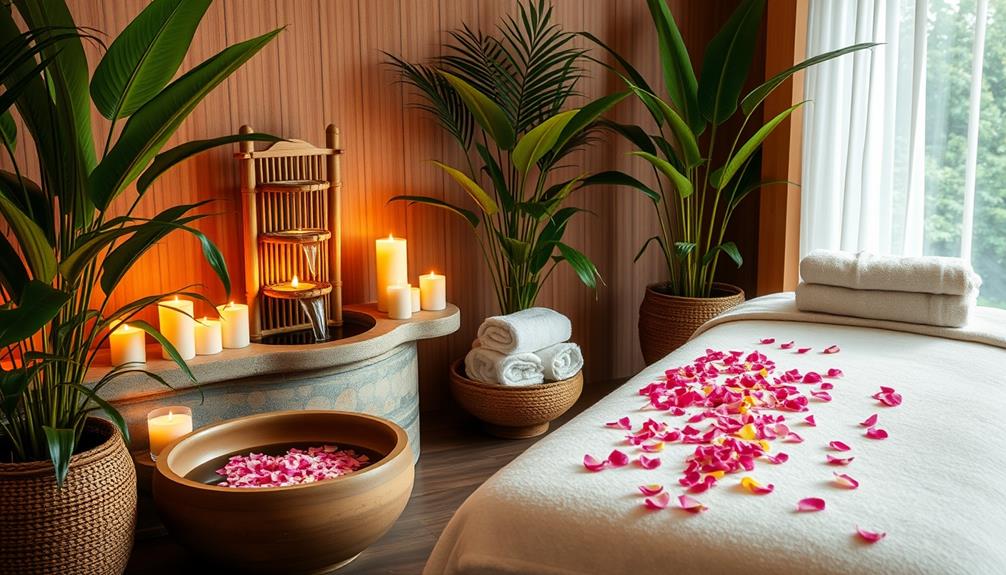To clean old wooden furniture naturally, combine three parts hemp or walnut oil with one part distilled white vinegar. This mixture is great for both cleaning and conditioning the wood. Use a soft cloth to apply it, following the direction of the grain for optimal results. Remember to test the solution on a hidden area before applying it to the entire surface to prevent any damage. For stubborn stains, consider using a mild dish soap solution or a paste made from baking soda and toothpaste. Keeping your furniture dusted regularly and maintaining a controlled environment will help preserve its beauty. Discover additional useful tips for keeping your beloved pieces in excellent condition.
Key Takeaways
- Mix 3 parts hemp or walnut oil with 1 part distilled white vinegar for a natural furniture cleaner.
- Regularly dust with a soft cloth to prevent dirt buildup and maintain wood's beauty.
- Use a damp cloth for cleaning, avoiding excess moisture to protect wood surfaces.
- For stains, apply a paste of baking soda and toothpaste gently, or use non-gel toothpaste for water stains.
- Keep furniture in a climate-controlled environment to minimize damage from temperature and humidity fluctuations.
DIY Furniture Cleaner Recipe
When it comes to cleaning old wood furniture, you can easily whip up a DIY cleaner that's both effective and natural. To create your own cleaner, mix 3 parts oil—like hemp or walnut oil—with 1 part distilled white vinegar. This combination hydrates and cleans wood surfaces without damaging them. The vinegar acts as a natural cleaning agent, while the oil conditions the wood, ensuring it stays fresh without the risk of rancidity that comes from using kitchen vegetable oils.
Additionally, maintaining your furniture can help you avoid financial mistakes to avoid that stem from neglecting asset care.
When you're ready to clean, grab a soft cloth and apply the mixture, working along the wood grain for the best results. Buff the surface until it shines, bringing out the beauty of the wood. Before diving in, it's wise to test your DIY furniture cleaner on a small, inconspicuous area first. This way, you'll confirm it doesn't harm the finish or the wood itself.
If you have any leftover cleaner, store it in a small jar for future use, allowing you to maintain your furniture effortlessly. Enjoy your revitalized wood surfaces with this simple, natural solution!
Effective Cleaning Techniques

To keep your old wood furniture looking its best, you'll want to use natural cleaning solutions that hydrate and protect the wood.
Regular preventive maintenance, like dusting and using mild soaps, can help you avoid more intensive cleaning later on.
It's beneficial to reflect on home remedies for cleaning which often utilize effective natural ingredients.
Let's explore some effective techniques that will guarantee your furniture stays beautiful and well-maintained.
Natural Cleaning Solutions
Cleaning old wood furniture naturally not only preserves its beauty but also guarantees the safety of the materials. You can create effective natural cleaning solutions right at home. For a great furniture cleaner, mix three parts oil—like hemp or walnut—with one part vinegar. This combination cleans and conditions your old wood in one go.
Additionally, make certain that the environment where the furniture is kept has good air quality, as this can help maintain its integrity over time. For tips on maintaining clean air, check out air purifier maintenance.
Regularly dusting with a clean cloth is essential to prevent dirt buildup. For deeper cleaning, use a gentle solution of mild dish soap mixed with water. If you encounter stubborn stains, apply a paste made of equal parts baking soda and toothpaste. Gently rub it with a soft cloth to lift the mark without harming the wood.
To tackle mildew or greasy residues, mix equal parts distilled white vinegar and water. The acetic acid in vinegar helps combat mold while being gentle on your wood.
Preventive Maintenance Practices
Maintaining the beauty of old wood furniture goes beyond just cleaning; it involves adopting preventive maintenance practices that keep it in top condition.
Start with regular cleaning by dusting your furniture with a soft cloth. This simple act prevents the buildup of dirt and oils, which can dull the finish and necessitate more intensive cleaning later on.
When you need to wipe down surfaces, grab a damp cloth made from cotton or an old T-shirt. Make sure not to saturate the wood, as excess moisture can lead to damage.
For deeper cleaning, mix three parts oil, like hemp or mineral oil, with one part vinegar. This solution hydrates and cleans without using harsh chemicals.
If you're caring for antique pieces, always test any new cleaning solution on an inconspicuous area first to verify it won't harm the finish or wood.
Additionally, keep your furniture in a climate-controlled environment to minimize exposure to humidity and temperature changes, which can cause warping or cracking.
Incorporate these preventive maintenance practices to enjoy your old wood furniture for years to come.
Choosing the Right Oils

When it comes to choosing oils for your old wood furniture, hemp oil is a top pick for its hydration properties and pleasant scent.
You'll want to avoid kitchen vegetable oils, as they can cause rancidity and damage over time.
Mixing your selected oil with vinegar in a three-to-one ratio creates an effective natural cleaner that nourishes and protects your wood surfaces.
Preferred Oil Types
Choosing the right oil for your old wood furniture can make all the difference in preserving its beauty and longevity. Hemp oil is an excellent choice because it hydrates wood surfaces effectively without leaving a strong odor. This non-stinky nature makes it ideal for regular cleaning and maintenance.
Walnut oil is another effective option. It nourishes the wood while preventing rancidity, a common issue with standard kitchen vegetable oils. This means you can keep your furniture looking fresh without worrying about unpleasant smells or sticky residues.
When selecting oils, always opt for food-safe oils like Miss Mustard Seed Hemp oil. These oils are specifically designed for furniture care and won't emit harmful chemicals, ensuring a safe environment for your home.
Avoid using oils that aren't meant for furniture, as they won't provide the same cleaning and conditioning benefits. Always check specialized websites like mmsmilkpaint.com or Etsy for availability.
Oil Application Techniques
Applying oil to your old wood furniture can seem challenging, but with the right techniques, it becomes a straightforward task. Start by choosing the appropriate oil. Food-safe oils like Hemp oil or Walnut oil are excellent options since they prevent rancidity and provide a natural finish. Alternatively, mineral oil is a good choice for hydrating wood surfaces, though it may not condition as deeply.
Here's a handy comparison of oils to help you decide:
| Oil Type | Best For | Notes |
|---|---|---|
| Hemp Oil | Antique finishes | Deep conditioning, food-safe |
| Walnut Oil | Cleaning & nourishing | Adds richness, food-safe |
| Mineral Oil | General hydration | Affordable, less conditioning |
| Specialized Oil | Heavily worn surfaces | ideal for furniture care |
Always prioritize oils meant for furniture care, as other oils might damage your wood furniture. Consider the specific needs of your piece; some oils perform better on antique finishes or worn surfaces. The right oil not only cleans but also revitalizes the wood, enhancing its appearance and ensuring longevity.
Addressing Common Stains
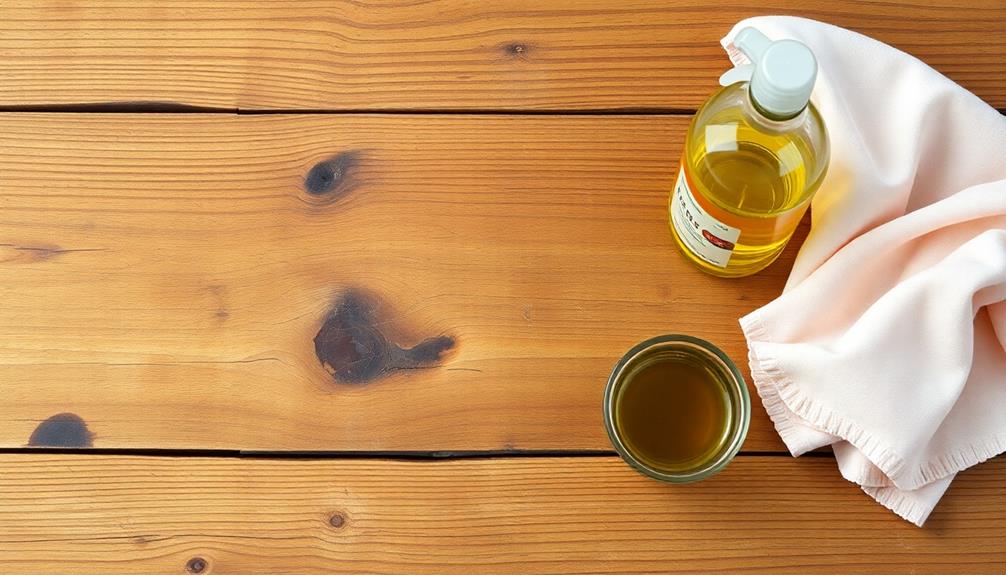
Addressing common stains on old wood furniture can breathe new life into your cherished pieces. You might encounter various stains, but don't worry; you can clean wood furniture without damaging it by following these simple methods:
- Water Stains: Apply non-gel toothpaste directly to the stain and rub with a soft cloth until it lifts. For stubborn stains, make a paste of equal parts baking soda and toothpaste.
- Ink Stains: Mix one tablespoon of baking soda with one teaspoon of water to form a paste. Gently apply it to the stain and wipe off the residue with a damp cloth.
- Mild Watermarks: Use a mixture of three parts vegetable oil and one part vinegar. This not only cleans but also conditions the wood, camouflaging those pesky marks.
- Grease Stains: For kitchen grease, consider using Howard Products Restor-A-Finish, which effectively removes grease and restores worn finishes.
Removing Old Polish
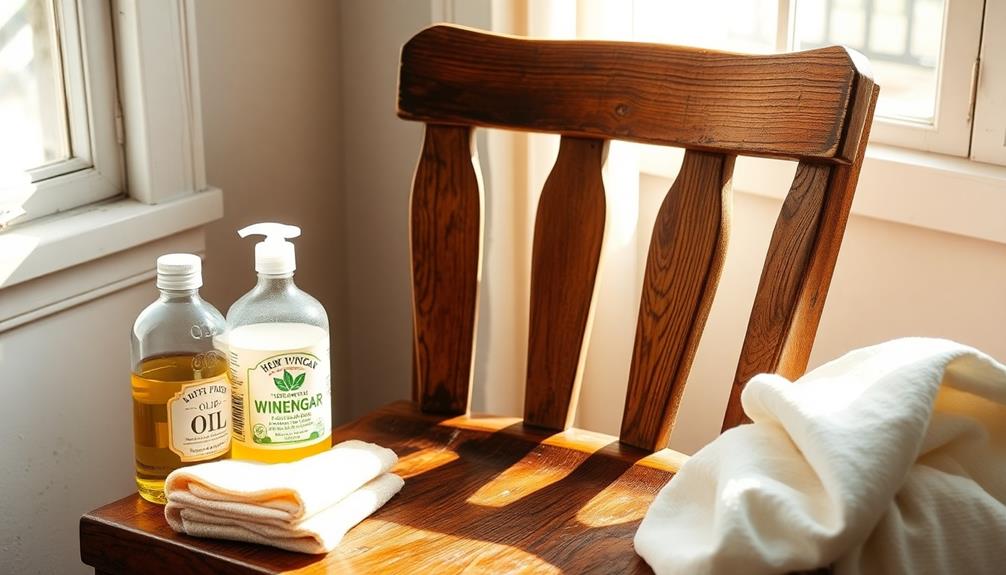
After tackling those common stains, you might notice a dull layer of old polish that's clouding your furniture's beauty. To remove old polish effectively, you can clean wood furniture without harsh chemicals. Start by steeping two tea bags in boiling water. Once cooled to room temperature, wring a soft cloth in the tea until it's damp. Gently clean the wood surface, allowing the tannic acid in the tea to enhance the shine.
Before diving in, it's essential to test the tea on a small inconspicuous area of your furniture. This way, you can confirm it won't damage the finish. Here's a quick overview of the cleaning process:
| Steps | Description |
|---|---|
| 1. Steep Tea | Boil water and steep two tea bags. |
| 2. Cool & Wring | Cool the mixture, then wring a soft cloth in it. |
| 3. Clean Surface | Gently clean the wood, avoiding saturation. |
| 4. Dry Thoroughly | Make sure the surface is completely dry afterward. |
Regularly using this method can help eliminate decades of polish buildup, revitalizing your antique furniture beautifully.
Maintaining Wood Furniture
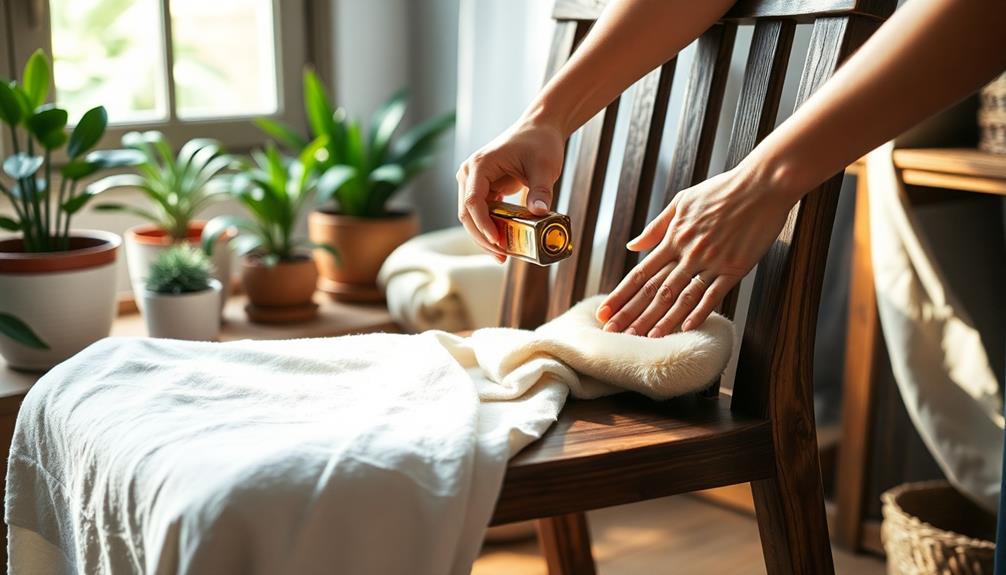
Maintaining wood furniture requires consistent care to keep it looking its best. Regular attention to your pieces not only enhances their beauty but also prolongs their lifespan.
Here are some essential tips to help you maintain your wood furniture effectively:
- Dust Regularly: Use a soft cloth to dust your furniture weekly, preventing dirt and oils from dulling the finish.
- Deep Clean Periodically: About every few months, perform a deep cleaning with a gentle soap and water solution. Remember to apply it with a damp cloth to avoid saturating the wood.
- Hydrate with Oils: When polishing, use natural oils like olive oil. This not only adds shine but also helps hydrate the wood and protects it from drying out.
- Control the Environment: Keep your furniture in a climate-controlled area and out of direct sunlight to maintain its beauty and condition.
Special Considerations for Antique Pieces
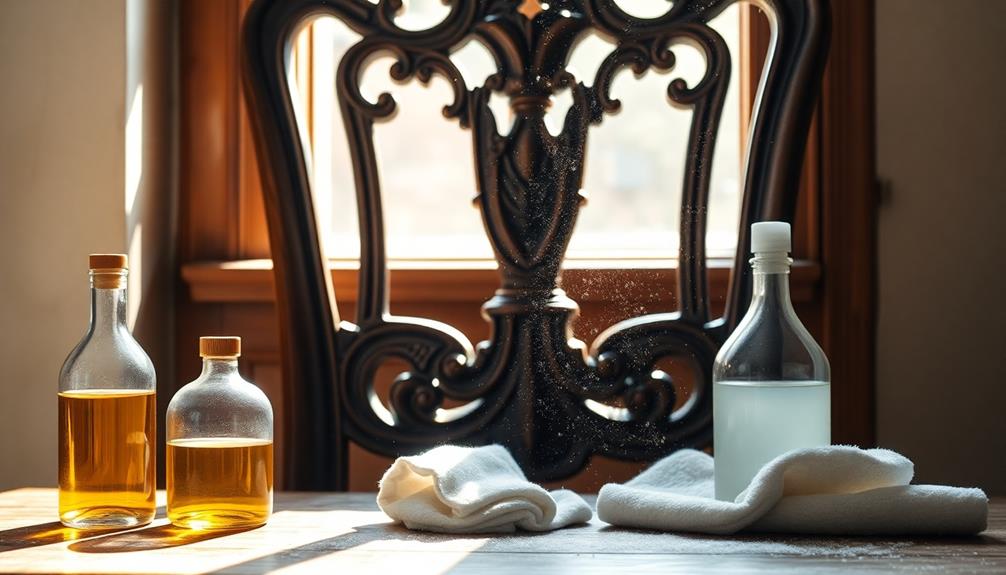
Antique wood furniture possesses a charm and history that modern pieces often lack, but it also demands special care. Before you start cleaning, it's vital to identify the unique finish of your antique piece. Using inappropriate cleaning methods can cause irreversible damage. Conduct a test on an inconspicuous area with denatured alcohol to determine the type of finish, which will guide you in selecting the right cleaning method.
When cleaning antiques, avoid excessive moisture and harsh chemicals, as these can compromise delicate finishes and the piece's historical integrity. Instead, consider a mixture of oil soap and water or natural oils like linseed or olive oil. These options effectively clean antique wood while maintaining its luster without causing harm.
Regular maintenance is important to preserve the beauty and longevity of your antique wood furniture. Be sure to dust gently and perform periodic cleanings with suitable products.
Community Tips and Inspiration
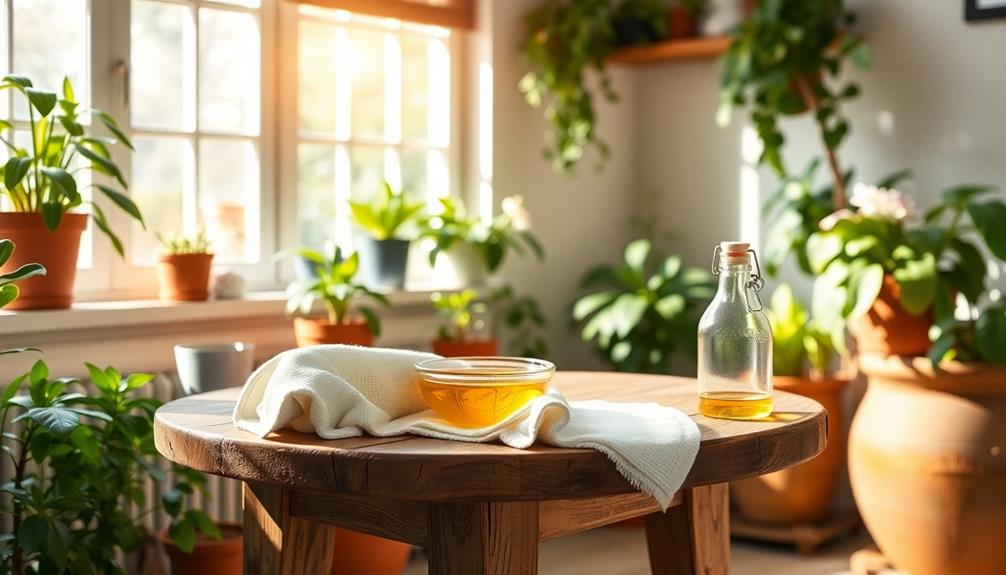
The wood furniture community is filled with valuable insights and inspiration that can enhance your cleaning and restoration efforts. By connecting with others who share your passion, you can discover effective methods to clean your wood and maintain its beauty.
Here are some tips to get you started:
- Engage with community blogs: These often share DIY furniture cleaning tips and foster shared experiences among wood furniture enthusiasts.
- Use natural cleaning solutions: Ingredients like vinegar and olive oil are cost-effective and environmentally friendly alternatives to commercial products, perfect for cleaning antique wood furniture.
- Share your stories: Whether it's a success or a challenge, sharing your experiences can inspire others and spark creative solutions within the community.
- Join online forums and groups: These platforms are great for exchanging advice on specific techniques and products that have worked for others.
Participating in local workshops or community events also provides hands-on learning and sharing of good old decorating tips.
Frequently Asked Questions
How Do You Remove Years of Grime From Wood Furniture?
To remove years of grime from wood furniture, start by dusting with a soft cloth. Then, mix oil and vinegar for cleaning. For stubborn spots, use a baking soda paste, rinsing thoroughly afterward. After cleaning, buff the surface with a clean, dry cloth to restore the wood’s natural sheen. To repair deep wood scratches, rub a small amount of wood filler or a matching wax crayon into the damaged area. Finally, finish with a polish or paste wax to seal and protect the wood for lasting beauty. To keep your furniture looking its best, it’s important to regularly maintain its finish and take care of any minor damage promptly. If you need to repair deep scratches in wood, acting quickly can help prevent further damage and preserve its appearance. Over time, repeated cleaning and polishing will not only enhance the wood’s patina but also protect it from future wear.
What Is the Best Cleaner for Vintage Wood Furniture?
When it comes to vintage wood furniture, think of it as a cherished treasure that needs care. You'll find a mixture of oil and vinegar or Howard Products Restor-A-Finish to be your best allies.
What Is the Best Thing to Clean Wood Furniture With?
To clean wood furniture effectively, you've got options. Use a mix of olive oil and vinegar for conditioning, or try mild soap with water for a gentle cleanse. Always test new solutions on a small area first.
How to Clean 100 Year Old Wood?
Cleaning 100-year-old wood's like unearthing a treasure; you've got to be gentle. Start by dusting, then use a mild soap solution. Always dry quickly to keep it from warping. Treat it with care, and it'll shine!
Conclusion
By using natural methods, you're not just cleaning your old wood furniture; you're breathing new life into it. With the right DIY cleaner and techniques, your pieces can shine like the sun after a storm. Remember to maintain them regularly and address stains promptly to keep them looking their best. So roll up your sleeves and immerse yourself—your furniture deserves the care, and you'll enjoy the satisfaction of reviving these timeless treasures!
